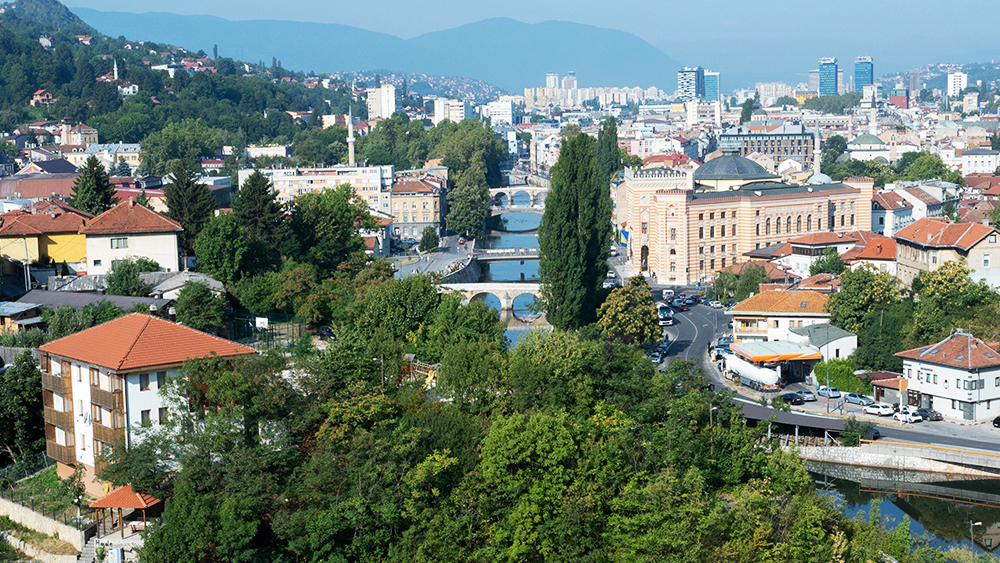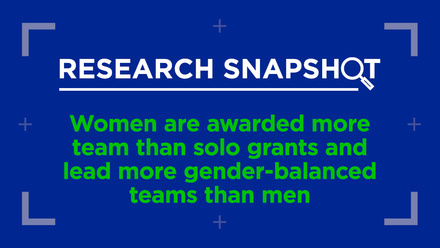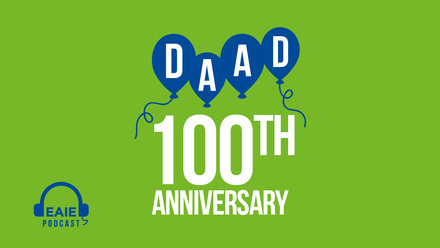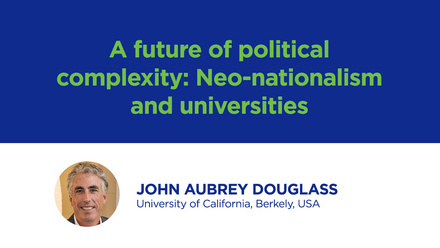The University of Sarajevo: A story of building back better

The University of Sarajevo (UNSA), Bosnia and Herzegovina's oldest and largest higher education institution, has a rich history marked by change and resilience. Throughout its journey, one constant remains: a distinct commitment to international collaboration. In this blog, we explore the University of Sarajevo's history, highlighting its enduring dedication to growth, evolution and renewal.
A long history, a new start
"Only the educated are free, able to decide on their future." This was a notion frequently emphasised in the years prior to the University of Sarajevo’s foundation by the State Anti-fascist Council for the National Liberation of Bosnia and Herzegovina (ZAVNOBiH). In 1943, in the midst of World War II, ZAVNOBiH restored the statehood of Bosnia and Herzegovina, which had been forcefully terminated five centuries earlier. Following the devastation of WWII, the (re)construction of a new modern state clearly required an educated and trained population. To meet this need, UNSA was founded in 1949. It was the first higher education institution established in Bosnia and Herzegovina after WWII, though it could trace its origins to a Madrassah dedicated to the study of Sufi philosophy that was established in 1537.
Early enthusiasm for international engagement
UNSA entered into its first international cooperation agreement with the University of Greifswald (then Ernst-Moritz-Arndt-University) in 1965. Over the next 15 years, additional agreements were signed with the University of Budapest, the University of Innsbruck, Alexandru Ioan Cuza University and the University of Bursa. The 1987 International Cooperation Department Report suggests that UNSA had a wide-ranging desire for relationships with universities around the world, including those in neighbouring countries, in non-aligned and developing countries, in both socialist countries and the developed countries of Europe and America, as well as in different kinds of cities, such as those with which Sarajevo had special friendships and connections, cities that had hosted the Olympic Games and those in provinces that had intensive economic cooperation with Bosnia and Herzegovina.
Crisis and change
UNSA’s development was forcefully interrupted by brutal aggression and devastating destruction. From 1991 to 1996, the University entered a new period that saw the dissolution of the Socialist Federal Republic of Yugoslavia, the first multi-party elections in Bosnia and Herzegovina and the four-year-long siege of Sarajevo, which deeply impacted the work of the University, its professors and students, and the country’s creative and educational activities overall.
This aggression against Bosnia and Herzegovina, as has been verified by the International War Crimes Tribunal in the Hague (ie the Srebrenica genocide), happened during a period of transformation, when the university was developing new educational content and was searching for more efficient forms of management. Alas, the majority of the country’s public institutions, including the University of Sarajevo, were completely or partly destroyed during the shelling of the city. Remarkably, the University management, together with other employees, managed to preserve the university's continuity and dignity, owing in large part to staff members’ amazing enthusiasm.
With full support of the War Presidency of the Republic of Bosnia and Herzegovina and various institutions in Sarajevo, UNSA managed to continue operating throughout the siege despite severe shortages and dangerous living conditions. Teaching and learning took place in highly unfavourable conditions where the lives of both students and professors were at stake. The support provided by numerous European and non-European universities during this period is important to highlight. These include the University of Barcelona (and, by extension, the city of Barcelona, which offered its support and named one of its districts Sarajevo) and a number of Austrian universities, primarily Graz University, which welcomed many students to continue their studies there.
After the war period and the passing of the Dayton Constitution in 1995, the country’s cantons were given the responsibility for education. Thus, the University of Sarajevo was adopted by the Canton of Sarajevo and no longer enjoyed a systematic, state-wide organisational approach. This development has affected the university's ability to ‘build back better’ in several ways— psychologically, politically and financially. For two generations in the post–WWII period, the institution served the entire Republic of Bosnia and Herzegovina and received priority funding as a centre of national importance. Today, while the university continues to serve the whole nation, it relies mainly on the Canton of Sarajevo – itself part of a reduced higher education system – for operational and financial support. These shifts are difficult to reckon with.
Post-1995
Post-war reconstruction of the University of Sarajevo involved both the reconstruction of buildings and the procurement of necessary teaching equipment. This was made possible via donations from various friendly countries and organisations, including Austria, Canada, Italy, the European Union and the United Nations. The damage was repaired to a certain extent, and thanks to a number of donor projects between 1995 and 2000, the university was even able to grow.
The university community was reconstructed alongside the physical rebuilding. In September 2003, Bosnia and Herzegovina signed the Bologna Declaration, cementing the nation's commitment to working towards a harmonised European Higher Education Area (EHEA). In 2005/2006, UNSA students began studying in accordance with the reformed study programme and innovated standards – the so-called Bologna principles. This opened a new stage of development for the University of Sarajevo.
The University of Sarajevo today
Today, UNSA is comprised of 22 faculties, three academies and five research institutes, organised within six science/arts groups focused on a wide range of fields and enrolling 25,000 students.
The University’s international cooperation activity has been consistently changing and shifting in form and intensity. Today, after 75 years of successful work, UNSA can proudly boast a strong international network that is formalised through ongoing agreements/memoranda with over 300 universities worldwide. Our strength and growth in international cooperation are reflected in 153 Memoranda of Understanding and more than 220 Erasmus+ Interinstitutional Agreements. From 2019 to 2023, outgoing student mobility grew by 6% (from 341 to 388), and outgoing staff mobility grew by 64% (from 237 to 388).
The university's mission is to build its reputation as a flexible, creative and reliable partner and to cement its much-deserved position in regional, European and global academic scenes. In that sense, UNSA’s International Cooperation Office has not only put a lot of effort into making the University of Sarajevo as attractive as possible in all of the European Commission's mobility programmes but also in bilateral and multilateral programmes with various countries.
The quality, cooperation, persistence and innovation of the International Relations Office are demonstrated not only by UNSA’s numerous partnerships but also by the University’s International Staff Week. Twelve such events have taken place since 2012, bringing together the representatives of foreign partner institutions and featuring enriching programmes that have strengthened these key institutional relationships. Additionally, for 14 consecutive years, the Scholarship Fair, a unique event in Bosnia and Herzegovina, has assembled many public and private actors (including embassies, universities, governmental and non-governmental organisations and student associations) to offer support (financial, social, structural etc), for academic experiences in Bosnia and Herzegovina and abroad.
Lessons learned
Thanks to the courage and commitment of its leadership and community, the University of Sarajevo, even in the most difficult times, never stopped working and promoting excellence in knowledge and science, always through the prism of universal human values. In accordance with this orientation, the University of Sarajevo became part of the European university initiative called EUPeace (European University for Peace, Justice, and Inclusive Societies). In this way, our university continues the long-standing tradition of inter-university cooperation for the development of a culture of dialogue and the promotion of peace.
The university invests significant time and effort to keep pace with the development within the EHEA. Owing to international grants, programmes and projects, the university stands out in the EHEA and is globally recognised in the field of capacity building and resilience in higher education. Significant effort goes into ensuring access to and participation in international projects, as these activities ensure mutually beneficial results and are cost-effective ways to boost the institution's international engagement. UNSA participates in Erasmus+, Horizon Europe, overseas cooperation programs, and individual initiatives. It capitalises on its specific strengths, particularly its academic tradition, action-oriented academic culture and openness to the world.
It's been a long journey of construction and reconstruction, but the university's resilience and its ability to withstand war, geopolitical disturbances and large-scale systematic change is a testament to the dedication of the university community. Building back better is possible.






